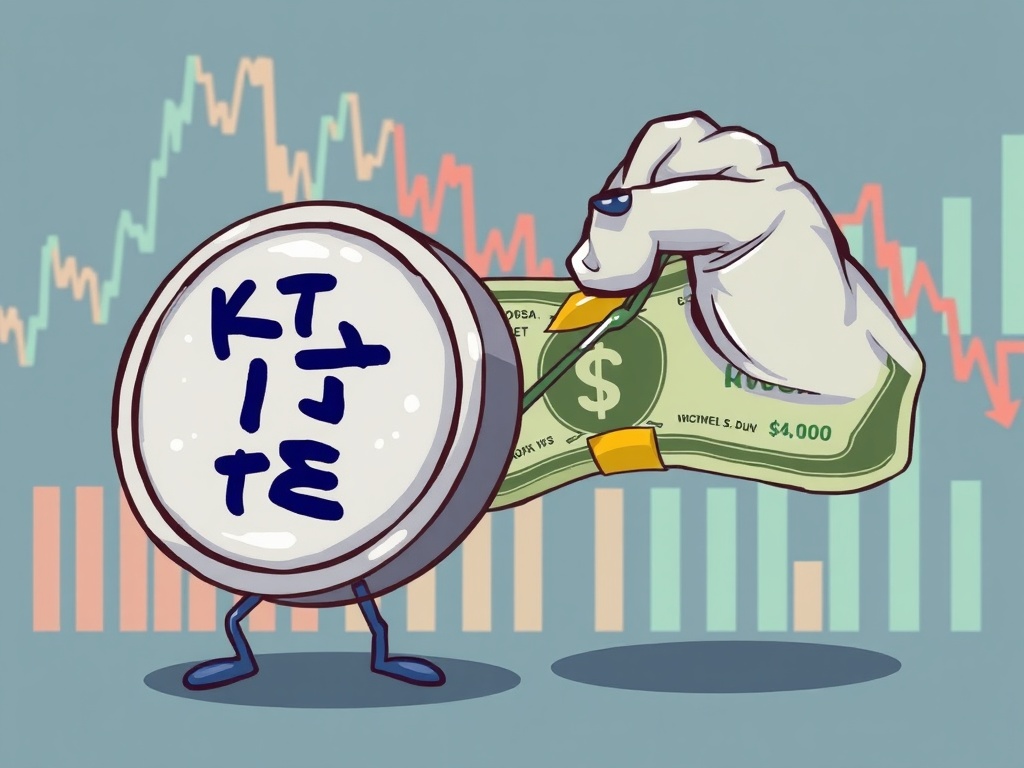BitcoinWorld

Korean Won Plunge: Unpacking the Dramatic Breach of 1,400 Against the Dollar
The financial world is abuzz with news from East Asia, as the Korean Won has just crossed a significant and rather concerning threshold. For the first time since May 19, the Korean Won (KRW) has weakened past the 1,400 mark against the mighty U.S. dollar (USD), now trading at approximately 1,400.30 won to the dollar. This isn’t just a number; it’s a stark indicator of shifting economic tides and warrants a closer look at what’s driving this movement and its potential ripple effects across various sectors, including the dynamic world of cryptocurrency.
What Does This Breach Mean for the Korean Won and Its Economy?
The 1,400 won per dollar level is more than just a psychological barrier; it represents a significant depreciation of the Korean Won. When a currency weakens to this extent, it signals underlying economic pressures. The last time the Korean Won saw these levels was just a few months ago, indicating persistent challenges rather than a fleeting anomaly. For an export-oriented economy like South Korea, a weaker currency can be a double-edged sword. While it theoretically makes exports cheaper and more competitive, it also drives up the cost of essential imports, particularly energy and raw materials, fueling domestic inflation.
This depreciation can have a broad impact on the daily lives of South Koreans and the nation’s economic health. Consider these key areas:
- Import Costs: Everything from oil to semiconductors, which Korea heavily imports, becomes more expensive. This directly impacts manufacturing costs and consumer prices.
- Inflationary Pressures: Higher import costs translate into higher consumer prices, eroding purchasing power for households.
- Corporate Profits: Companies reliant on imported raw materials or those with significant foreign debt may see their profit margins squeezed. Exporters, however, might see a boost in their competitiveness.
- Investment Flows: A weakening currency can make a country’s assets less attractive to foreign investors, potentially leading to capital outflows.
Why is the Korean Won Weakening? Unpacking the Drivers
Understanding the factors behind the Korean Won‘s recent slump requires looking at both global and domestic economic landscapes. Several powerful forces are at play, contributing to this significant depreciation:
Global Economic Headwinds: A Stormy Outlook
The world economy is grappling with a confluence of challenges. Persistent inflation, aggressive interest rate hikes by major central banks (especially the U.S. Federal Reserve), and growing fears of a global recession are creating an environment of risk aversion. In such times, investors often flock to safe-haven assets, with the U.S. dollar typically being the primary beneficiary. As capital flows into the dollar, other currencies, including the Korean Won, naturally weaken.
Interest Rate Differentials: The Fed’s Dominance
One of the most significant drivers is the widening interest rate differential between the U.S. and South Korea. The U.S. Federal Reserve has been steadfast in its commitment to taming inflation, implementing a series of robust rate hikes. While the Bank of Korea has also raised rates, its pace and magnitude have sometimes lagged behind the Fed’s. This disparity makes dollar-denominated assets more attractive to investors seeking higher returns, drawing capital away from the Korean Won and exacerbating its depreciation.
Trade Balance Concerns: A Shifting Landscape
South Korea, a powerhouse in exports of semiconductors, automobiles, and petrochemicals, is highly sensitive to global trade dynamics. Recent data has shown a deteriorating trade balance, with imports growing faster than exports, partly due to high energy prices. A persistent trade deficit indicates that more dollars are leaving the country than entering, putting downward pressure on the Korean Won.
Geopolitical Tensions and Energy Prices: Added Volatility
Ongoing geopolitical tensions, particularly the conflict in Ukraine, continue to keep global energy prices elevated. South Korea is a major energy importer, meaning higher oil and gas prices translate directly into increased import bills and a greater demand for foreign currency to pay for them. This structural demand for dollars further contributes to the weakening of the Korean Won.
The Ripple Effect: How Does a Weak Korean Won Impact the Crypto Market?
While currency fluctuations might seem distinct from the volatile world of cryptocurrencies, there’s often a fascinating interplay. For investors in South Korea, a weakening Korean Won can trigger several reactions within the local crypto ecosystem:
- Safe-Haven Demand: In times of currency depreciation and economic uncertainty, some investors may view cryptocurrencies, particularly Bitcoin (BTC) or stablecoins like USDT, as an alternative store of value or a hedge against inflation and local currency weakness. This can lead to increased demand for crypto assets.
- Premium on Stablecoins: When the Korean Won depreciates significantly, the local price of stablecoins pegged to the U.S. dollar (e.g., USDT, USDC) can trade at a premium on South Korean exchanges. This ‘Kimchi Premium’ (or rather, a reverse Kimchi Premium if KRW is weaker) can become more pronounced, reflecting the demand for dollar-denominated assets.
- Increased Trading Activity: Volatility in traditional financial markets often spills over into crypto. Investors might shift funds between traditional assets and crypto, leading to increased trading volumes on South Korean crypto exchanges.
- Regulatory Scrutiny: Significant currency movements might prompt regulators to increase their scrutiny of capital flows into and out of crypto markets, especially if they perceive crypto as a channel for capital flight.
It’s a complex dynamic, but generally, a weakening local currency can make dollar-pegged assets, including stablecoins, more attractive, potentially driving up their local prices and increasing interest in the broader crypto market as a diversification tool.
What’s Next for the Korean Won? A Look Ahead
The immediate focus will be on how South Korean authorities, particularly the Bank of Korea (BoK), respond to this depreciation. The BoK has a delicate balancing act: raising interest rates too aggressively to support the Korean Won could stifle economic growth, while not doing enough risks further depreciation and inflation. Potential actions include:
- Monetary Policy Adjustments: Further interest rate hikes to narrow the gap with the Fed and make KRW assets more attractive.
- Market Intervention: Direct intervention in the foreign exchange market by selling U.S. dollars from its reserves to buy Korean Won, thereby supporting its value.
- Communication: Clear communication from policymakers to reassure markets and manage expectations.
Beyond domestic policy, the future trajectory of the Korean Won will heavily depend on global factors, especially the U.S. Federal Reserve’s monetary policy path and the overall health of the global economy. Any signs of easing inflation in the U.S. or a pivot by the Fed could alleviate pressure on emerging market currencies, including the Korean Won.
Navigating Volatility: Actionable Insights for Investors
In times of currency volatility, both traditional and crypto investors need to remain vigilant and adaptable. Here are some actionable insights:
- Stay Informed: Keep a close eye on economic data releases from South Korea, the U.S., and global markets. Understand the nuances of central bank policies.
- Diversify Your Portfolio: Don’t put all your eggs in one basket. Diversifying across different asset classes and geographies can help mitigate risks associated with currency fluctuations.
- Consider Hedging Strategies: For businesses or individuals with significant exposure to foreign currency, exploring hedging instruments can help protect against adverse movements in the Korean Won.
- Long-Term Perspective: While short-term volatility can be unnerving, a long-term investment strategy, especially in fundamentally strong assets, often weathers currency storms more effectively.
- Assess Crypto Exposure: If you hold crypto, understand how local currency depreciation might affect your portfolio’s value when converted back to Korean Won. Stablecoins can offer a temporary haven, but they also carry their own risks.
Conclusion: A Dynamic Landscape for the Korean Won
The breach of the 1,400 mark by the Korean Won against the U.S. dollar is a significant development, reflecting the complex interplay of global economic forces, monetary policy divergences, and domestic economic conditions. While it presents challenges in the form of increased import costs and inflationary pressures, it also highlights the dynamic nature of currency markets and their interconnectedness with broader financial ecosystems, including cryptocurrency.
Monitoring the responses of the Bank of Korea, the Federal Reserve, and global economic indicators will be crucial for understanding the future path of the Korean Won. For investors and consumers alike, adaptability and informed decision-making will be key to navigating these turbulent waters.
Frequently Asked Questions (FAQs)
Q1: What does it mean when the Korean Won weakens against the U.S. Dollar?
A1: It means that it takes more Korean Won to buy one U.S. Dollar. This effectively makes U.S. goods and services more expensive for South Koreans, while making South Korean exports cheaper for those buying with U.S. Dollars.
Q2: Why is the Korean Won weakening now?
A2: Several factors contribute, including aggressive interest rate hikes by the U.S. Federal Reserve making the dollar more attractive, global economic slowdown fears, high energy prices increasing import costs for Korea, and a deteriorating trade balance.
Q3: How does a weak Korean Won affect South Korean consumers?
A3: It generally leads to higher prices for imported goods, including food, energy, and electronics, which can fuel domestic inflation and reduce purchasing power.
Q4: Can a weak Korean Won impact the cryptocurrency market?
A4: Yes. A weakening local currency can sometimes drive local investors towards cryptocurrencies, particularly stablecoins pegged to the U.S. dollar, as a potential hedge against inflation or a store of value. This can lead to increased demand and local price premiums for these assets.
Q5: What measures can the Bank of Korea take to strengthen the Korean Won?
A5: The Bank of Korea can consider raising interest rates further to attract foreign capital or intervene directly in the foreign exchange market by selling U.S. dollar reserves to buy Korean Won, thereby increasing its demand and supporting its value.
Q6: Is this a permanent trend for the Korean Won?
A6: Currency movements are highly dynamic and influenced by a multitude of ever-changing factors. While the current depreciation is significant, its long-term trajectory will depend on global economic recovery, central bank policies, and South Korea’s own economic performance. It’s rarely a permanent, one-way street.
If you found this article insightful, please consider sharing it with your network! Your support helps us continue to provide timely and comprehensive analyses of critical financial and crypto market developments.
To learn more about the latest crypto market trends, explore our article on key developments shaping Bitcoin price action.
This post Korean Won Plunge: Unpacking the Dramatic Breach of 1,400 Against the Dollar first appeared on BitcoinWorld and is written by Editorial Team





